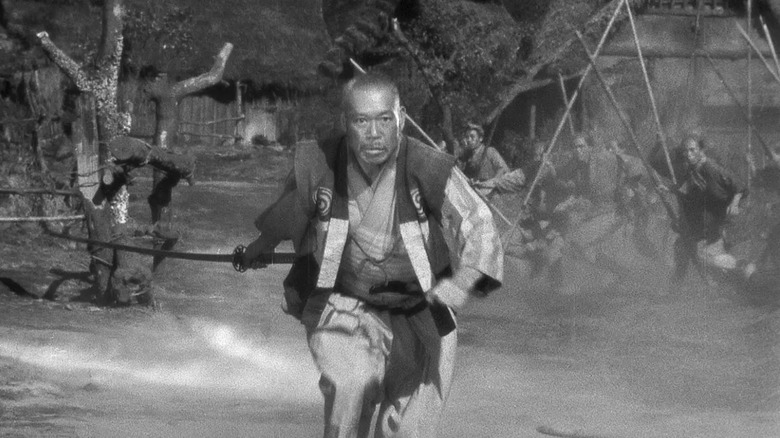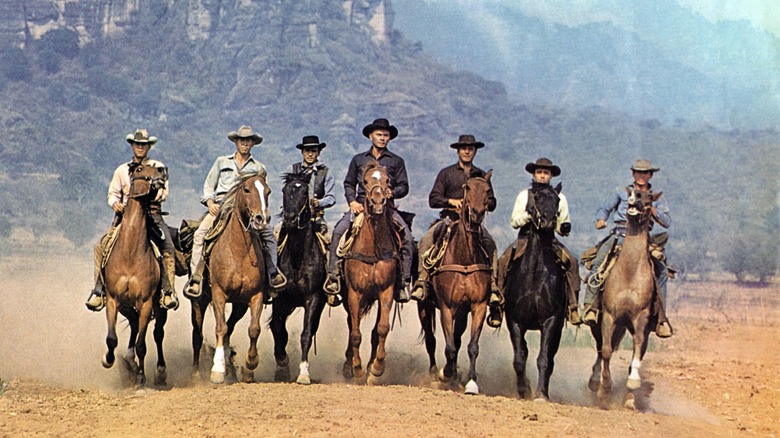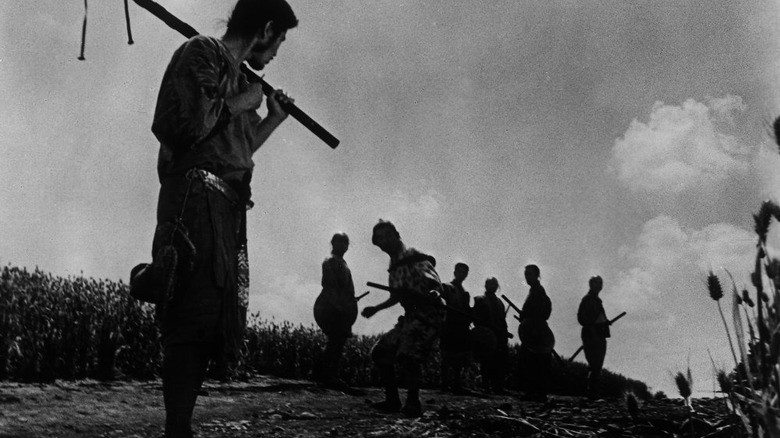Seven Samurai's Rights Took A Complicated Route From Akira Kurosawa To The Magnificent Seven
If one were to remove Akira Kurosawa's 1954 film "Seven Samurai" from cinema history, the entire medium would look different. "Seven Samurai" is one of the linchpins in action cinema, codifying the language of an entire genre. Additionally, its premise — a helpless village is beset by bandits, requiring the starving citizens to hire a small, affordable, and ill-equipped gang of scrappy defenders — is universally applicable to any genre. A keen observer might see the "Seven Samurai" story repeated frequently across film history; "Galaxy Quest," "A Bug's Life," "Battle Beyond the Stars," "The Invincible Six," and the fourth episode of "The Mandalorian" all repeat Kurosawa's film openly.
The most famous "Seven Samurai" retelling, however, is probably John Sturges' 1960 Western remake "The Magnificent Seven." The story between the "Sevens" is identical, with the samurai replaced by horse-riding cowboy archetypes, played by a cadre of internationally recognized movie stars. Charles Bronson, Steve McQueen, and Yul Brynner were among the titular group. "The Magnificent Seven" was initially something of a box office bust in the United States but became a bit hit in Europe, aided by the fact that the Russian-born Brynner proved to be a huge box office draw in his home country. "Magnificent" grew in estimation over the decades to become a well-regarded classic of the genre.
In the 2008 book "Escape Artist: The Life and Films of John Sturges," handily quoted on the website Cinemadope, author Glenn Lovell describes the very, very circuitous route "Seven Samurai" took to get to its 1960 remake, as well as the many, many hands through which the remake rights passed. By 1960, it seemed like everyone had touched the project.
The rights
Initially, the American remake rights to "Seven Samurai" were owned by a screenwriter named Lou Morheim who wrote the scripts for films like "The Beast from 20,000 Fathoms," and TV shows like "The Outer Limits," "The Big Valley," and "Rawhide." He would also eventually serve as an executive producer on the project. It was Morheim who pitched the Western "Seven Samurai" idea to actor Anthony Quinn as a potential vehicle. Quinn was so taken with the idea that, just like the villagers in the movie itself, he began trekking around Hollywood looking for other team members to join him. Quinn pitched Morheim's idea to Yul Brynner, a hot commodity after the successes of "The King and I" and "The Ten Commandments," both from 1956.
Brynner also loved the idea and somehow wrested it away from Quinn, deciding to make the film on his own terms. Brynner took the lead role and began developing a script with producer Walter Mirisch. It was during this phase of production that the original samurai were transformed into untrustworthy ex-gunfighters and that the film would be shot in widescreen technicolor on a budget of $2 million (a modest $20 million in 2022 dollars). Cinemascope had only been introduced to the public with "The Robe" in 1953, so the format was still something of a novelty.
Lovell, in an interview on the Cinemadope website, tells the story of how Mirisch sold a Western "Seven Samurai" to United Artists. Mirisch, the story goes, arranged a screening of Kurosawa's movie on the studio lot with other UA executives and producers. Mirisch recalls everyone in the room having a grand experience translating the classic into Western terms in real time. It was a pitch meeting by way of "Mystery Science Theater 3000."
Westerns to samurai to Westerns
According to Lovell's book, Quinn tried to sue Brynner for $650,000 for stealing his idea after the two of them discussed — and possibly officially developed — the project together. Quinn, however, was unsuccessful. It seems that he had no legal recourse as there was nothing in writing.
Because of an impending writers strike, Sturges felt he had to get "The Magnificent Seven" finished quickly. He assembled his cast as fast as possible, luckily landing other bankable movie stars including McQueen, Bronson, James Coburn, and Robert Vaughn. Anthony Quinn did not appear in the film.
As is repeated ad nauseam in any film school, Kurosawa took inspiration from American Westerns to make his samurai films which, in turn, inspired the makers of a new generation of American Westerns. Kurosawa is not quoted in any particular source on this, however — it is merely a generally agreed-upon critical consensus. One can find any number of non-Japanese filmmakers, though, transposing Kurosawa's stories into other genres. The master's "Yojimbo," for instance, became both Sergio Leone's "A Fistful of Dollars" as well as Walter Hill's "Last Man Standing."
"The Magnificent Seven," as stated above, was not a hit upon its release, but did eventually expand in popularity to the point where sequels could be made. "Return of the Seven" came out in 1966, followed by "Guns of the Magnificent Seven" in 1969 and "The Magnificent Seven Ride!" in 1972. The film itself was remade by Antoine Fuqua in 2016 with Denzel Washington.
Kurosawa never made a sequel to "Seven Samurai."


